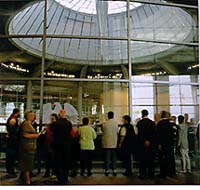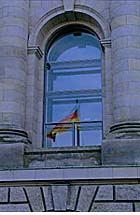| Der Deutche Bundestag | The New German Parliament, Reichstag |
Glass of The New German Parliament | |

The highly transparent glass curtain-wall Photo by Aoki Tsukasa |
||
|
The Dome and its glass The structure of the Dome The Dome is 40 meters in diameter, 23.5 meters in height from the Roof Terrace level and 1200 ton in total weight. Twenty-four steel pillars with triangular cross-sections sustain this towering structure. Two caracoles (spiral stairs, 1.6 m in width and 230 m in length) for ascent and descent are suspended from the pillars. A glass-mirror-covered cone, weighing 300 tons, is also suspended, and it penetrates the Top Light above the Assembly Hall. At the bottom, the cone is stabilized with rods to prevent it from swinging. Working just like the bands around a huge pail, the 17 horizontal rings reach around the main post sustaining the glass covering the Dome. The top of the Dome has a round opening for emitting the hot air rising upward from the Assembly Hall. The Dome and glass of the "Light Sculptor" The glass panels covering the Dome is arranged in a saw-tooth like sequence, in consideration of upward air currents, are made of highly-transparent, tempered laminated glass (12mm+ 12mm). In total, there are 404 glass panes with a total area of 3,000 square meters. The glass is low in iron content, which increases its transparency. It has an internal layer (1.52 mm thick), which blocks 99.8% of the ultraviolet rays. The structural gasket (structural glazing) fixed to the sashes are integrated into the structure of the Dome. The maximum size of the glaze is 1720 X 5010mm (for the lowest part of the Dome), with the minimum size being 1770 X 1660 (found at the highest part of the Dome). 360 slices of mirror-laminated glass panes are fixed to the "Light Sculptor" for controlling the amount of light flooding down on the Assembly Hall. The Top Light above the Hall is equipped with Low-E double laminated glass (53 mm in total thickness), which shuts off fire, heat, and noise, while also being bulletproof in case of an emergency. The performance is summarized by these features: The G30 fire rating (equivalent to 30 minutes of resistance to fire), 45dB in sound insulation, 1.4w/ m2K of u-value, and 75% light transmittance. Glass symbolizes the concept of a "Legislature open to the public" Working toward open politics The New Bundestag is as open to the public as the Old Bundestag in Bonn (designed by Guenter Benisch). Especially, the Western Entrance, used for easy access by ordinary people is fitted with only two transparent glass separators between the Assembly Hall and the passage. So visitors can see everything going on in the Hall. The entrance area is almost level with the Hall, so one can see deep across the Hall, the center of which is only 20 meters away from the entrance. So, a visitor gets the impression as if he or she were seeing a stage performance as legislative actions unfold before their very eyes. Abundant light emanating the Top Light makes every legislator clearly visible, bringing them closer to the people who they represent. Here again, one is reminded of the very open attitude toward the transparency of their democracy. |
The highly transparent glass curtain-wall This glass curtain wall, which visually connects the Assembly Hall with citizens, is as tall as 16 meters. Too thick sashes and mullions would spoil the optical pleasure, even though they are required to fulfill such important functions as a fire wall, a sound insulator, and a bulletproof shield in case of an emergency. The glass used here is double fireproofed glass (PYROSTOP) (with a total thickness of 48 mm). It has a G30 fire rating and 45dB in sound insulation. The layers of glass and sodium silicate (liquid glass) are laminated alternatively. Sodium silicate will sparkle in case of fire and insulate the heat source. Although the glass weighs 80kg/ m2, its maximum size is 2770 X1350mm to assure good performance such as maximum transparency. But the face of sash is only 70mm X 149.5mm in dimension. To embody these fine and slender curtain walls, the architects have anchored the glass panes in the body at the upper part of the wall. The lower part of the glass panes are supported on the floor with springs (ca. 200 mm in diameter and ca. 600 mm long) which apply tension. The "Intelligent Window" enhances natural ventilation The pre-existing openings are termed 'intelligent' In addition to the Dome and the curtain walls of the Assembly Hall, the Bundestag building has some more amazing features such as the "intelligent windows" as their designers named them. Most of the pre-existing openings are made to this style. Safety and ecology by means of the double skin The Intelligent Window is composed of double skin. A fixed sash window containing tempered laminated glass is fitted between the outer wall and the inner wall, with a small space in between. At some places, the spaces are as much as one meter deep. The window is fitted with double glazing which can be opened and closed manually (sliding after drawing inward the lower part of the glass) or by electromotive means: The upper part, close to the ceiling, can be opened by drawing the glass inward. The inside of the sash is fitted with electromotive blinds, which block the intense sunlight. Across the inner sash run fine pipes with hot water flowing inside, which prevent cold drafts and act as a small heating panel for the building's interior. The double skin design serves to block the sunlight and prompt higher insulation and natural ventilation, which contribute to reduce the amount of energy used for air-conditioning and ventilating. | |

The "Intelligent Window" Photo by Aoki Tsukasa | ||
Data of this building | ||
| Previous Page | Next Page | |
|
To Index In English | ||